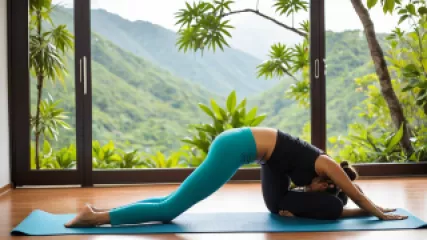Top 10 Yoga Poses for Stress Relief Techniques
Are you feeling overwhelmed by stress? Looking for effective ways to relax and find mental peace? Look no further than yoga! Yoga is not only a physical practice but also a powerful tool for promoting mental health and well-being. By combining gentle movements, deep breathing, and mindfulness, yoga can help reduce stress, relieve anxiety, and improve overall mental well-being.
In this article, we have compiled a list of the top 10 yoga poses for stress relief techniques. These poses are beginner-friendly and can be practiced by anyone, regardless of their yoga experience. So, grab your mat, find a quiet space, and let's dive into these relaxing poses!
1. Child's Pose (Balasana)
Child's Pose is a restorative yoga pose that helps release tension in the back, shoulders, and neck. It promotes relaxation and calms the mind. To practice Child's Pose:
- Kneel on the floor with your knees hip-width apart and your toes touching.
- Sit back on your heels and slowly lower your torso down, resting your forehead on the mat.
- Extend your arms forward or place them alongside your body, palms facing up.
- Breathe deeply and hold the pose for 1-3 minutes, focusing on releasing any tension or stress.
2. Standing Forward Fold (Uttanasana)
Standing Forward Fold is a gentle inversion that helps calm the nervous system, relieve stress, and stretch the hamstrings and lower back. To practice Standing Forward Fold:
- Stand tall with your feet hip-width apart.
- Exhale and fold forward from your hips, reaching your hands towards the ground or resting them on your shins.
- Allow your head and neck to relax.
- Bend your knees slightly if you feel any discomfort in your hamstrings.
- Hold the pose for 1-2 minutes while taking slow, deep breaths.
3. Cat-Cow Pose (Marjaryasana-Bitilasana)
Cat-Cow Pose is a gentle flowing movement that helps release tension in the spine, stretch the back muscles, and massage the organs. It promotes flexibility and reduces stress. To practice Cat-Cow Pose:
- Start on your hands and knees, aligning your wrists under your shoulders and your knees under your hips.
- Inhale, arch your back, lift your chest, and gaze up (Cow Pose).
- Exhale, round your spine, tuck your chin, and draw your navel towards your spine (Cat Pose).
- Continue flowing between Cow Pose and Cat Pose for 5-10 rounds, syncing your breath with the movement.
4. Legs-Up-The-Wall Pose (Viparita Karani)
Legs-Up-The-Wall Pose is a restorative inversion that helps calm the nervous system, relieve anxiety, and reduce fatigue. It also improves circulation and relieves swollen ankles. To practice Legs-Up-The-Wall Pose:
- Sit sideways next to a wall with your knees bent and your hip touching the wall.
- Slowly lie down on your back and swing your legs up against the wall.
- Keep your arms relaxed by your sides, palms facing up.
- Close your eyes and breathe deeply, staying in the pose for 5-10 minutes.
5. Bridge Pose (Setu Bandhasana)
Bridge Pose is a gentle backbend that helps release tension in the chest, shoulders, and back. It stimulates the abdominal organs, promotes relaxation, and reduces stress. To practice Bridge Pose:
- Lie on your back with your knees bent and your feet hip-width apart, heels close to your glutes.
- Place your arms alongside your body, palms facing down.
- Inhale, press your feet into the mat, and lift your hips off the ground, engaging your glutes and inner thighs.
- Keep your chin slightly tucked and your gaze towards your chest.
- Hold the pose for 30 seconds to 1 minute, breathing deeply.
6. Standing Forward Bend with Shoulder Opener
This variation of the Standing Forward Bend targets the shoulders, upper back, and hamstrings, promoting relaxation and relieving stress. To practice this pose:
- Stand tall with your feet hip-width apart and your arms relaxed by your sides.
- Interlace your fingers behind your back, pressing your palms together.
- Exhale and fold forward from your hips, bringing your hands overhead and allowing them to fall towards the ground.
- Relax your neck and shoulders.
- Bend your knees slightly if needed.
- Hold the pose for 1-2 minutes, breathing deeply and gently swaying from side to side.
7. Seated Forward Bend (Paschimottanasana)
Seated Forward Bend is a calming pose that stretches the entire back body, stimulates digestion, and soothes the nervous system. It helps relieve anxiety and promotes relaxation. To practice Seated Forward Bend:
- Sit on the mat with your legs extended in front of you.
- Flex your feet, pressing your heels into the ground.
- Inhale, lengthen your spine, and exhale, fold forward from your hips.
- Reach for your shins, ankles, or feet, depending on your flexibility.
- Relax your head, neck, and shoulders.
- Hold the pose for 1-3 minutes, breathing deeply and surrendering to the stretch.
8. Reclining Bound Angle Pose (Supta Baddha Konasana)
Reclining Bound Angle Pose is a deeply relaxing pose that opens the hips, relieves tension in the groin, and promotes a sense of calmness. It is particularly beneficial for reducing anxiety and stress. To practice Reclining Bound Angle Pose:
- Start by sitting on the mat with your knees bent and the soles of your feet touching.
- Slowly lie down on your back and allow your knees to drop out to the sides, bringing the soles of your feet together.
- Place your arms alongside your body, palms facing up.
- Close your eyes and breathe deeply, staying in the pose for 5-10 minutes.
9. Corpse Pose (Savasana)
Corpse Pose is a final relaxation pose that allows the body and mind to fully relax and integrate the benefits of the practice. It reduces stress, promotes deep rest, and rejuvenates the nervous system. To practice Corpse Pose:
- Lie flat on your back with your legs extended and your arms relaxed by your sides, palms facing up.
- Close your eyes and allow your body to feel heavy and supported by the ground.
- Scan your body for any areas of tension and consciously release them.
- Focus on your breath, allowing it to become slow and steady.
- Remain in the pose for 5-10 minutes, letting go of any thoughts or worries.
10. Alternate Nostril Breathing (Nadi Shodhana Pranayama)
Alternate Nostril Breathing is a powerful breathing technique that balances the left and right hemispheres of the brain, calms the mind, and reduces stress. It promotes mental clarity and relaxation. To practice Alternate Nostril Breathing:
- Sit in a comfortable cross-legged position, placing your left hand on your left knee.
- Bring your right hand towards your face and place your index and middle fingers between your eyebrows.
- Close your right nostril with your thumb and inhale deeply through your left nostril.
- At the top of the inhalation, close your left nostril with your ring finger, release your thumb from your right nostril, and exhale through your right nostril.
- Inhale through your right nostril, close it with your thumb, release your ring finger from your left nostril, and exhale through your left nostril.
- Continue this pattern for 5-10 rounds, focusing on the smooth flow of breath and the calming effect it has on your mind.
Remember, yoga is not just about physical postures; it is a holistic practice that encompasses the mind, body, and spirit. By incorporating these stress-relieving yoga poses into your self-care routine, you can support your mental health and cultivate a sense of inner peace. So, take the time to care for yourself and discover the transformative power of yoga!






